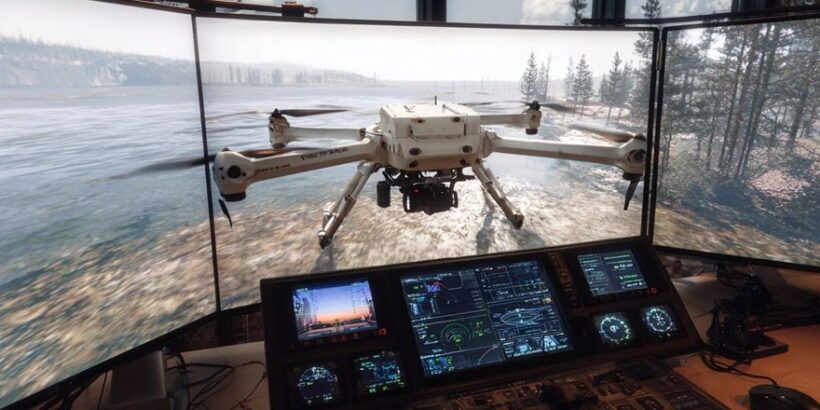The development of autonomous unmanned aerial vehicles (UAVs) requires close integration with artificial intelligence (AI) technologies. Testing and validating AI algorithms on actual UAVs involves significant risks and high costs. To address these challenges, the Moscow Aviation Institute (MAI) is developing a universal digital simulation platform for UAV flight, enabling ground-based testing and verification of AI modules prior to their deployment in operational systems, according to MAI representatives.
The platform is being developed by experts from MAI’s Department 701 (Aviation Robotic Systems) and Department 806 (Computational Mathematics and Programming), based in the Institute No. 8 Laboratory of Artificial Intelligence (Computer Science and Applied Mathematics). The simulator supports a full range of flight modes, including takeoff, landing, maneuvering, and long-range missions.
“The goal of this project is to comprehensively validate AI algorithms intended for onboard integration. For example, one practical scenario addressed by the simulator is testing a UAV’s navigation function in the event of lost communications, ensuring the vehicle can safely return to base,” said Vadim Kondaratsev, Head of the Laboratory of Artificial Intelligence at MAI Institute No. 8.
Leveraging modern game engines, particularly the Russian-developed Unigine platform, the simulator generates highly detailed 3D environments with photorealistic graphics. This approach enables the creation of virtual settings that closely replicate real-world conditions, including both visual and infrared spectrums.
Unlike widely known simulators such as AirSim and Gazebo, the MAI platform combines high-fidelity modeling with seamless AI module integration, focusing on comprehensive UAV testing.
AirSim, developed by Microsoft, utilizes Unreal Engine and Unity to deliver impressive photorealistic graphics and robust tools for training and testing autonomous control algorithms. However, AirSim demands substantial computing resources and advanced expertise to configure complex scenarios. Its primary use cases are research and prototyping, which can limit scalability and industrial integration.
Gazebo is a popular open-source platform that integrates well with the Robot Operating System (ROS) and offers advanced tools for physical modeling and sensor simulation. While Gazebo provides strong performance and flexibility, creating realistic 3D environments and complex terrains can require significant computational resources and time, and its visual fidelity lags behind modern game engines.
The MAI digital platform combines the strengths of both international solutions, offering photorealistic visual modeling based on the Unigine engine, advanced sensor emulation, and user-friendly tools for loading and debugging AI algorithms. This integrated approach enables not only isolated module testing but also comprehensive validation of autonomous UAV control systems in a variety of extreme scenarios, including communication loss and equipment failures. As a result, the MAI platform is well-suited for industrial deployment and scalable algorithm development without the high costs associated with flight testing.
The system features realistic emulation of UAV sensor suites, including optical and infrared cameras, lidars, radars, GPS and GLONASS receivers, as well as inertial and barometric sensors. This enables thorough testing of navigation and autonomy algorithms, obstacle avoidance, and control strategies under diverse conditions. The platform supports the integration and debugging of neural networks, reinforcement learning methods, computer vision algorithms, decision-making systems, and adaptive control architectures. It can simulate a wide range of scenarios, such as communication loss and hardware failures, facilitating the assessment of AI solution reliability and robustness.
Iterative debugging and optimization of algorithms in the virtual environment accelerate development cycles and improve final product quality. The simulator’s ability to replicate extreme conditions helps identify and resolve issues early in the development process. Unlike specialized emulators, the MAI platform offers a highly integrated and comprehensive approach, enabling validation of AI modules throughout all flight phases and in various onboard system interaction scenarios.
According to Vadim Kondaratsev, the platform’s key advantage lies in its integration of advanced UAV technologies with AI capabilities. “Moreover, our system models not only individual aspects but also the entire operational environment. It is a vivid example of the advancement of domestic technologies,” he added.
MAI representatives told the “Aviation of Russia” portal that the project is actively used for developing new control algorithms, and a pilot version of the platform is currently undergoing trials at a partner enterprise within the defense industry. The first version is scheduled for integration into the customer’s production processes by the end of 2025. In parallel, work continues on a second version aimed at expanding versatility and functionality.
The creation of a universal digital UAV simulation platform at MAI significantly reduces costs and enhances safety in the implementation of AI for unmanned systems. This project ensures reliable technology validation and contributes to the development of domestic competencies in the aerospace sector.


